Pei Ling tells us what exactly we’re breathing in these days.
I can’t seem to find what air pollutants are in the haze and their health effects from our papers, so I did my own research.
These pollutants are usually in the air and we do breath them in in negligible amount when the air is clear (API below 50). But their percentage are higher in the haze.
(1) Particulate matter (PM/habuk halus): PM affects more people than any other pollutant. PM10 and below are worse. The major components of PM are sulfate, nitrates, ammonia, sodium chloride, carbon, mineral dust and water. Chronic exposure to particles contributes to the risk of developing cardiovascular and respiratory diseases, as well as of lung cancer.
(2) Sulfur dioxide (SO2): This is what gives the haze the acrid smell. It is produced from the burning of peat forests. SO2 can affect the respiratory system and the functions of the lungs, and causes irritation of the eyes. Inflammation of the respiratory tract causes coughing, mucus secretion, aggravation of asthma and chronic bronchitis and makes people more prone to infections of the respiratory tract. Hospital admissions for cardiac disease and mortality increase on days with higher SO2 levels.
(3) Carbon monoxide (CO): A gas produced from incomplete combustion. This gas prevents the uptake of oxygen by the blood, which can lead to a significant reduction in the supply of oxygen to the heart, particularly in people suffering from heart diseases.
(4) Nitrogen dioxide (NO2): A reddish-orange-brown gas with an irritating, acrid, characteristic pungent odor. In sunlight, nitrogen dioxide can lead to the formation of ozone, nitric acid and nitrate-containing particles.
(5) Ozone (O3): Ozone at ground level – not to be confused with the ozone layer in the upper atmosphere – is one of the major constituents of photochemical smog. Excessive ozone in the air can have a marked effect on human health. It can cause breathing problems, trigger asthma, reduce lung function and cause lung diseases.
Other components present in the haze: Carbon dioxide (CO2) and water vapor from the burning.
If the API hits above 100 (unhealthy), those with stroke, heart or chronic lung disease should avoid all outdoor activities. Healthy individuals should minimise prolonged or strenuous outdoor activities.
Above 200 (very unhealthy), the elderly, pregnant women and children should avoid going outdoors and keep windows closed. Wear a face mask if you have to venture out.
Once the API crosses the threshold of 300, it’s hazardous, and even healthy individuals should avoid outdoor activities and wear an N95 mask when outdoors. But note that the use of N95 masks increases the effort in breathing and may cause discomfort. Children are not certified to use N95 masks. Latest API readings can be found at the Department Of Environment’s website or the Natural Resources and Environment Ministry’s Facebook page.
Finally, your body will be working doubly hard to eliminate the toxins you’re breathing in so drink lots of water, get enough sleep (at least six hours) and nutritious food.
Compiled from: World Health Organisation, UK Department for Environment, Food and Rural Affairs, Alberta Environment, and Singapore Health Advisory.


Hey, it was good to read!
I love this blog and I’m always so impressed with the high quality of your posts (that you put out EVERY DAY. How do you do that and stay sane???). It’s always a treat to read your blog in the morning before I tackle my day as a stay at home mom of four young kiddos. Thanks for helping me stay sane! ??
Site Pro 1
I am terribly dainty accompanying the info you're posting here. Bless for sharing moreover endure us to view additional about unprecedented frees on this accessible many acknowledges for taking the phase to participate this convenient analysis beside everyone.
So informative matters are provided here,I absolutely happy to study this publish,i used to be truly recollect approximately it and also you furnished me the first-class records.
Because may be pOinted out, standard may be the excellent stratifier, which is within the foldable from the masturbator sleeves that folks could be sieved.
Dear Ms. Gan,
“exactly what we’re breathing in”
“pollutants are usually in the air and we do breath them in in negligible amount when the air is clear (API below 50)”
Much better if invisible?!
Perhaps you could also check out the radioactive substances we are breathing in and their sources… especially since we are about to expand considerably our own coal-fired electrical sources here on the west coast of the peninsula. Chimney precipitators and scrubbers are between 95 and 98% efficient when working well… allowing only a portion of the the finest particulates to escape.
By the way the coal ash, classified as TENORMs in the US, is currently put to “green” uses here such as building materials! Compared with Lynas?
Ng Ai Soo
It is very important for individual pollutants concentration in the air during haze to be displayed for public consumption.Prolonged exposure (8 hrs/24 hrs) will have some health effects to humans.Ambient air quality standards for each pollutants will tell you how save is the air we breath at that particular moment.Therefore DOE should give us the value of each parameter /pollutants whether in compliance with the National Ambient Air Quality Standards or not..Although the standards are only guidelines value,it was already adopted and in tandem with WHO guidelines..With the presence of ozone and some other air pollutants,photo chemical smogs will be developed.What we are being informed all this while is just the value of API which is the computation of several parameters and most of the time the presence of PM10 supercedes the rest….What happen to the readings of individual pollutants with respect to the National Ambient Air Quality Standards comparison?
Because may be pOinted out, standard may be the excellent stratifier, which is within the foldable from the masturbator sleeves that folks could be sieved.